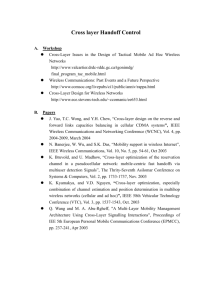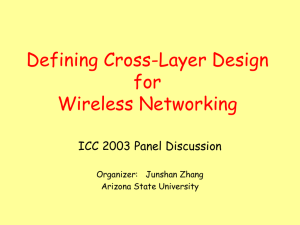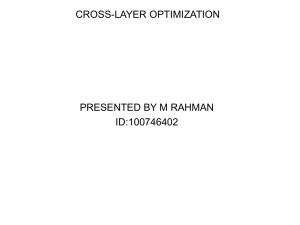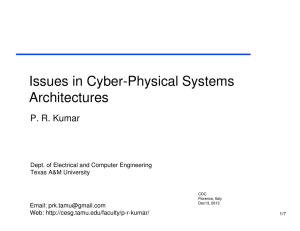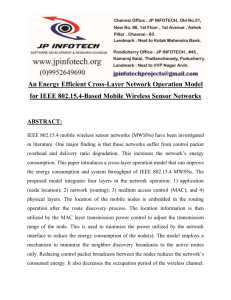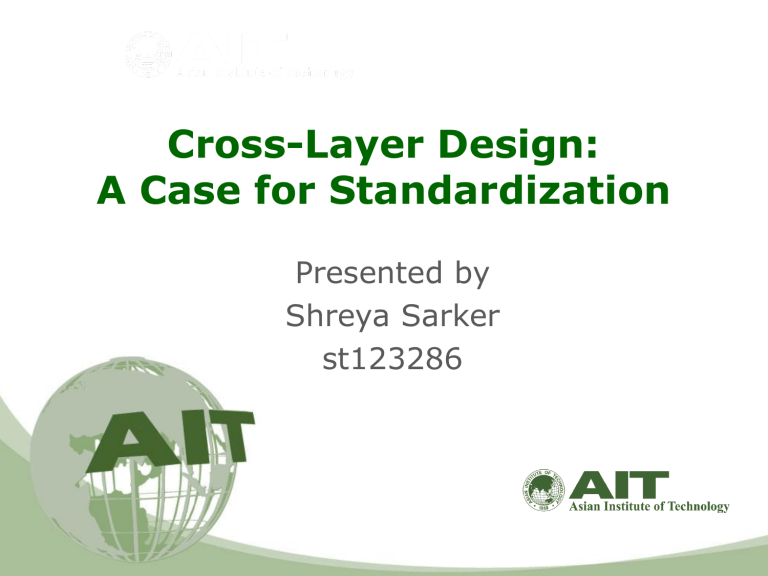
Cross-Layer Design: A Case for Standardization Presented by Shreya Sarker st123286 Presentation Outline INTRODUCTION BACKGROUND CROSS LAYER FRAMEWORKS (CLF) REVIEW OF CLF PROPOSALS METHODOLOGY (CROSS-LAYER DESIGN BY EXAMPLE) • REVIEW • CONCLUSIONS • • • • • INTRODUCTION • Wireless Sensor Networks (WSNs) • Open System Interconnection (OSI) reference model • Cross-layer design (CLD) • Cross-Layer Frameworks • Standardized? • Summary/Objective BACKGROUND • The OSI Model BACKGROUND • Cross-Layer Design Classes BACKGROUND • Potential issues with CLD I. Unintended Cross-Layer Interaction: lead to unforeseen dependencies which are not predicted by simulation. II. Stability: a given CLD may make changes at one layer based upon feedback from another layer. III. Long-term Sustainability: a change made at any given layer could affect the functionality of any other layer. CROSS LAYER FRAMEWORKS (CLF) 1. Direct Inter-layer Communication 2. Shared Super Layer 3. New Abstractions CROSS LAYER FRAMEWORKS (CLF) 1. Direct Inter-layer Communication: The DynamicMulti-Attribute Cross-Layer Design (DMA-CLD) framework was proposed. But, direct inter-layer communication is not a good approach for CLD. CROSS LAYER FRAMEWORKS (CLF) 2. Shared Super Layer: The Optimization Agent (OA) Framework is proposed. But, giving the OA unfettered access to every layer is dangerous. CROSS LAYER FRAMEWORKS (CLF) 3. New Abstractions: The TinyCubus framework is described. CROSS LAYER FRAMEWORKS (CLF) 3. New Abstractions: Divides WSN into three interdependent frameworks: I. Data Management Framework: selects appropriate operating modes for each sensor node. II. Cross-Layer Framework: incorporates sets of communication layers in order to create a functional communication system. III. Configuration Engine: responsible for network configuration and node updating. CROSS LAYER FRAMEWORKS (CLF) 3. New Abstractions But, It is not clear how a variety of CLD proposals would be cleanly incorporated into this framework, nor exactly how the application requirements and optimization goals should be chosen. REVIEW OF CLF PROPOSALS • STANDARD??? • For the creation of a universal CLF standard, more work and collaboration in this area is required. Additionally, a good CLF will define more than just communication blocks and allowable interactions. • Joint effort will be required in order to produce a capable CLF. METHODOLOGY (CROSS-LAYER DESIGN BY EXAMPLE) Evaluation Criterion (Forms of application Requirement) a. Optimization objectives: set of network lifetime b. System constraints Constructive constraints or Destructive constraints METHODOLOGY (CROSS-LAYER DESIGN BY EXAMPLE) Evaluation Criterion a. b. c. d. Define the involved layers Check system model and assumptions State the Optimization Objectives State the system constraints, constructive and destructive e. Explain the nature of the optimization f. Define new requirements for each involved layer METHODOLOGY (CROSS-LAYER DESIGN BY EXAMPLE) 1. Proposal: Optimization of Transmission Schemes METHODOLOGY (CROSS-LAYER DESIGN BY EXAMPLE) 1. Proposal: Optimization of Transmission Schemes a. Involved Layers: Physical, MAC, and Network b. Model & Assumptions: Assume a time-invariant network topology described by a directed graph G = (V, L) • • V is the set of nodes L is the set of links Assume Single commodity flow METHODOLOGY (CROSS-LAYER DESIGN BY EXAMPLE) 1. Proposal: Optimization of Transmission Schemes c. Optimization Objectives Total Power Consumption: Minimize Minimum Node Lifetime: Maximize Concave Functions of Node Lifetimes: as long as one node in that block can sense and report data METHODOLOGY (CROSS-LAYER DESIGN BY EXAMPLE) 1. Proposal: Optimization of Transmission Schemes d. System Constraints Data Rate: Destructive Energy Consumption: Destructive Flow Conservation: Destructive METHODOLOGY (CROSS-LAYER DESIGN BY EXAMPLE) 1. Proposal: Optimization of Transmission Schemes e. Optimization Methodology First, consider the TDMA case for lifetime maximization, subject to flow conservation, energy conservation, and other constraints. Second, the total network power minimization scheme is considered. Third, case for a slotted network with interfering links is studied. METHODOLOGY (CROSS-LAYER DESIGN BY EXAMPLE) 1. Proposal: Optimization of Transmission Schemes f. Cross-Layer Method & Interfaces There is Dynamic vertical calibration between the Physical, MAC, and Network layers, where the central controller is responsible for updating the calibration of every node. METHODOLOGY (CROSS-LAYER DESIGN BY EXAMPLE) 2. Proposal: Adaptive Quality of Service METHODOLOGY (CROSS-LAYER DESIGN BY EXAMPLE) 2. Proposal: Adaptive Quality of Service a. Involved Layers: MAC, and Network b. Model & Assumptions: Assume sensor network model is defined as an undirected graph G = (V, E) • V is the set of sensor nodes • E is the set of undirected wireless links between nodes. To pass information between cluster-heads, they identify and use neighboring members from different clusters to relay information. METHODOLOGY (CROSS-LAYER DESIGN BY EXAMPLE) 2. Proposal: Adaptive Quality of Service c. Optimization Objectives Energy efficiency such that minimum node lifetime is maximized. METHODOLOGY (CROSS-LAYER DESIGN BY EXAMPLE) 2. Proposal: Adaptive Quality of Service d. System Constraints (For Network and MAC Layer) End-to-end delay (Destructive Constraint) Where, Delay constraint τ Drep is defined as the total data reporting time Dprop is the one-hop propagation delay. Dproc is the amount of processing time for data fusion per cluster head. Hint is the number of intermediary clusterheads. Finally, k is the number of nodes within the data source cluster. METHODOLOGY (CROSS-LAYER DESIGN BY EXAMPLE) 2. Proposal: Adaptive Quality of Service d. System Constraints Spatial Correlation (Constructive Constraint): The vector of measurements from any two nodes can be used to calculate a spatial correlation coefficient, ρij. METHODOLOGY (CROSS-LAYER DESIGN BY EXAMPLE) 2. Proposal: Adaptive Quality of Service f. Cross-Layer Method & Interfaces For the routing scheme, new interfaces into the Network layer are required, such that an optimal route to the data sink can be chosen. For the MAC scheme, the application layer is designed to specifically interact with a TDMA MAC, such that slots for a single node-per-block can be chosen. METHODOLOGY (CROSS-LAYER DESIGN BY EXAMPLE) Review No common methodology observed in developing or evaluating these ideas. CONCLUSIONS • OSI approach to communication systems design is not optimal. • Two proposed approaches for a CLF are viable but lack enough specification and definition. • STANDARDIZED FRAMEWORK FOR CLD NEEDED
